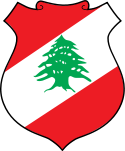- Maronite League
-
Lebanon 
This article is part of the series:
Politics and government of
LebanonPresidencyGovernment- Prime Minister
- Cabinet
Legislature- Parliament
- Current members
- Presidential 2008
- Parliamentary 2009
- Local 2010
Other issues- Governorates
- Districts
- Municipalities
- Armed Forces
- Human rights
- Foreign relations
The Maronite League – ML (Arabic: Al-Rabitat al-Maroun) or Ligue Maronite in French is a private, non-profit and ostensibly apolitical organization of Lebanese Christian notables, dedicated mainly to defend the independence and sovereignty of Lebanon in the cadre of a democratic and pluralistic society.
Contents
Composition
The League is often described as an exclusively Maronite “elitist group” whose membership was “automatic” for prominent figures in the public and private sector – Intellectuals, Businessmen, Bankers, Politicians (including former Heads of State, Members of Parliament, Government Ministers, and diplomats), Lawyers, Jurists, Public Servants, retired senior Army or Police officers, Presidents of Economic and Social Associations, Corporate Managers, and others.
Structure and organization
The Maronite League is run by a counsel of appointed senior members, the Executive Board, which is headed by an elected President. Board meetings are held at the League's Headquarters, in the Central Maronite Council Building located at Rue Medawar in Beirut. Being a non-profit organization, its primary source of funding comes from annual membership fees paid by its affiliates as well as private donations.
List of ML presidents (1952-present)
- Georges Tabet
- Dr.Elias Khoury
- Jean Abou Jaoudeh
- Shaker Abu Suleiman
- Ernest Karam
- Pierre Helou
- Michel Eddé
- Emir Hares Chehab
- Dr.Joseph Torbey
Political line
In reality, the ML is a Phoenicist-oriented lobby aimed at promoting Christian interests in the Lebanese Government and Parliament. Politically conservative, anti-communist and opposed to secularization, the group since the 1950s manoeuvred to neutralize any mesures that might threaten the political status quo, quietly exerting pressure on the authorities to lift legal bans on Maronite Church public activities or to restrict labour rights by curbing the Trade Unions.
History
First established on August 21, 1952 in Beirut by a group of Christian notables and intellectuals with Georges Tabet being elected as president in their first General Assembly, the Maronite League became more politicised towards the 1960s. The League strengthened its ties with Maronite Church leaders and due to their clear hostility towards Pan-Arabism, it also objected to the presence of Palestinian refugees and the PLO, advocating their total eviction from Lebanon.
Under the presidency of Shaker Abu Suleiman, an ardent supporter of Father Charbel Qassis, Superior General of the Order of the Maronite Monks, the League in the early 1970s provided secret financial support and cadres to the Christian militias, notably the secretive Al-Tanzim.
Civil War 1975-1990
Prior to 1975 Abu Suleiman – who was also secretly affiliated in the Al-Tanzim – even used the League’s funds to help that organization to raise their 200 men-strong militia,[1] which later saw heavy action in Beirut during the 1975-77 phase of the Lebanese Civil War, defending the Christian quarters against LNM/PLO forces’ attacks.
The League also helped in the founding the alliance of the Christian parties and militias known as the Lebanese Front in 1976 and, despite having the Tanzim militia absorbed into the Lebanese Forces in the following year, they managed to maintain themselves as a separate body.
Remaining active – again mostly behind the scenes – throughout the civil war, the League tried to encourage a rapprochement policy and reconciliation between the different Christian parties and militias during the violent inter-Christian strifes of the late 1970s and late 1980s.
The post-war years
Eventually, the ML emerged virtually unscathed in the post-war years as a powerful pressure group with some 700-1,300 current members, which continues to promote Christian interests in Lebanon and abroad. Its current President is Dr.Joseph Torbey, former CEO of the Credit Libanais Bank.
See also
Notes
- ^ Deeb, The Lebanese Civil War (1980), p.29.
Further reading
- Denise Ammoun, Histoire du Liban contemporain : Tome 2 1943-1990, Fayard, Paris 2005. ISBN 978-2213615219 (in French)
- Edgar O'Ballance, Civil War in Lebanon, 1975-92, Palgrave Macmillan, 1998. ISBN 978-0333729757
- Jean Sarkis, Histoire de la guerre du Liban, Presses Universitaires de France - PUF, Paris 1993. ISBN 978-2130458012 (in French)
- Rex Brynen, Sanctuary and Survival: the PLO in Lebanon, Boulder: Westview Press, 1990.
- Robert Fisk, Pity the Nation: Lebanon at War, London: Oxford University Press, (3rd ed. 2001). ISBN 0192801309
- Marius Deeb, The Lebanese Civil War, Praeger, New York 1980.
External links
- http://www.maronite-league.org.lb/ Maronite League official site.
Categories:- Israeli–Lebanese conflict
- Political parties in Lebanon
- Irregular military
- Lebanese Civil War
Wikimedia Foundation. 2010.
